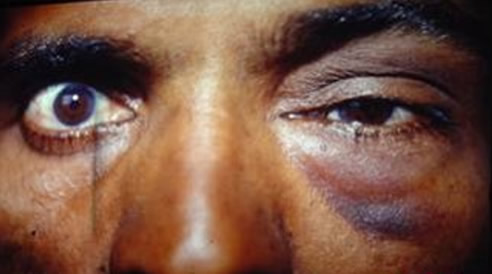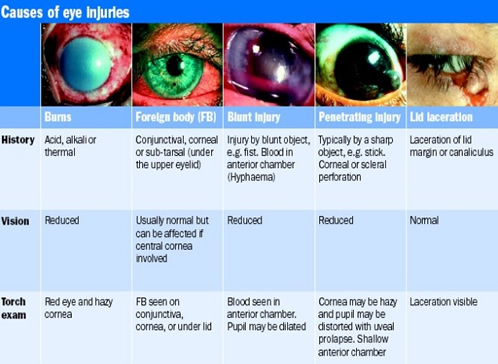
Eye trauma refers to damage caused by a direct blow to the eye. The trauma may affect not only the eye but the surrounding area, including adjacent tissue and bone structure.
There are many different forms of trauma, varying in severity from minor injury to medical emergencies. Even in cases where trauma seems minor, every eye injury should be given medical attention.
Eye injuries can occur in many settings, including at home, at work or when playing sports.
Common types of eye injury include:
⦁ Blow to the eye – such as being hit by a fist, elbow or ball. When the eye is hit with blunt force, it suddenly compresses and retracts. This can cause blood to collect underneath the hit area, which leads to many of the common symptoms of eye trauma.
⦁ Scratches and abrasions – such as from fingernails or tree branches
⦁ Foreign bodies – such as small pieces of grit, wood or metal getting in the eye
⦁ Penetrating or cutting injuries – such as cuts from glass or projectiles flung from tools, especially when hammering or using power tools
⦁ Chemical burns – such as exposure to household cleaning products
⦁ Radiation exposure – such as exposure to ultraviolet (UV) light from the sun or sun lamps
Wearing contact lenses incorrectly can also injure your eyes, particularly if they’re dirty, don’t fit properly or have been worn for too long.

Symptoms of Eye Trauma
Symptoms of eye trauma may include:
⦁ Pain
⦁ Trouble seeing
⦁ Cuts to the eyelid
⦁ One eye not moving as well
⦁ One eye sticks out
⦁ Blood in the clear part of the eye
⦁ Unusual pupil size or shape
⦁ Something embedded in the eye
⦁ Something under the eyelid that cannot be easily removed
Treatments for Eye Trauma
Every eye injury should be given medical attention; do not touch, rub or try to remove any object in the eye. If the eye has been cut or there is an object in the eye, rest a protective shield – such as a paper cup – on the bone around your eye. Make sure there is no pressure on the eye itself. Seek immediate, professional medical attention.
In minor cases of trauma, such as a black eye from a sports injury, applying cold to the affected area can help bring swelling down, and allow the affected area to heal faster. However, even in cases where trauma seems minor, every eye injury should be given medical attention.
Flushing your eye
If you have loose particles in your eye or your eye has been exposed to chemicals, flush it out with eyewash or plenty of clean water for at least 10 to 15 minutes. If you wear contact lenses, remember to remove them before flushing the eye.
You can flush your eyes in the following ways:
⦁ Sit down and slant your head so the injured eye is lower than the unaffected eye, ideally over a bath or sink, then use a glass or cupped hand to repeatedly pour water across the eye from the bridge of the nose.
⦁ If both eyes are affected, tilt your head back, keeping it level, and use a glass or cupped hand to repeatedly pour water across both eyes from the bridge of the nose.
⦁ If you have access to a shower, aim a gentle stream of warm water at your forehead or just above the affected eye while holding the affected eye open.
⦁ If you’re working outside, you can use a garden hose to rinse your eye using a very low flow setting.
All eye injuries caused by chemical exposure should be seen by an eye doctor as soon as possible after flushing. You should also seek immediate medical advice if there are still any foreign bodies in the eye after flushing it.
Don’t try to remove any objects embedded or stuck in the eye yourself, as this can damage the eye further. These should only be removed by an eye doctor.
When to seek immediate medical advice
You should go immediately to an eye doctor if you have:
⦁ persistent or severe eye pain
⦁ foreign bodies that can’t be washed out
⦁ decreased or double vision
⦁ flashing lights, spots, halos or shadows in your field of vision
⦁ blood visible in your eye
⦁ an irregularly shaped pupil (the black dot at the centre of the eye)
⦁ pain when exposed to bright light
⦁ deep cuts around your eye
⦁ your eye is sticking out of your eye socket
You should also go to your eye doctor if your injury was caused by an object flying at speed – for example, a projectile flung from an angle grinder; a very sharp object, such as glass or a knife; or chemical exposure. Flush your eye for at least 10 to 15 minutes before going.
Preventing eye injuries
Many eye injuries are preventable if you take appropriate safety precautions during leisure activities or work – for example, wearing eye protection when hammering metal and using power tools.
The best way to avoid eye trauma is to prevent it by using protective eyewear while doing things that may put them at risk. Activities include home repair, yard work, cleaning, cooking, and playing sports. In most cases of injury, people report not properly protecting their eyes – which shows that proper precautions may prevent an eye injury.
You should also follow instructions on the safe and hygienic use of contact lenses.
